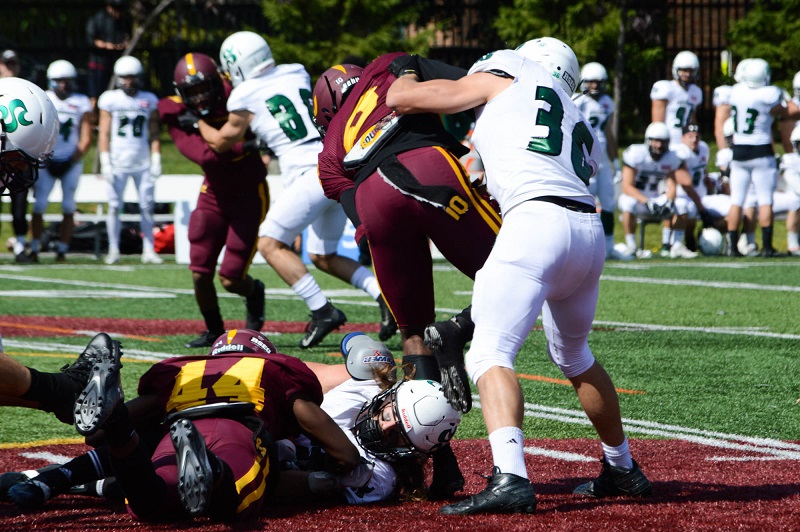Concordia scored 17 points in final six minutes to complete comeback win
The Concordia Stingers football team were trailing for 56 minutes of their home-opener against the Sherbrooke Vert et Or on Sept. 8 at the Concordia Stadium. A touchdown catch by wide receiver James Tyrrell gave the Stingers a 22-20 win as time expired, and helped improve their record to 1-1.
Stingers win on the last play of the game! Final score 22-20. pic.twitter.com/EmaSYJwuPd
— Matthew Coyte (@MatthewCoyte16) September 8, 2018
Heading into the second half down 9-0, the Stingers’s chances of beating the Vert et Or didn’t look good. They had been held to mostly ineffective plays, and any time they gained some momentum, it was quickly negated by penalties and turnovers.
Stingers quarterback Adam Vance said that the team just kept shooting themselves in the foot during the first half. Head coach Brad Collinson was not impressed with how his team came out in the first part of the game.
“I told them they had to look themselves in the mirror,” said Collinson about his halftime locker room talk with the team. “They had to make a decision coming out to that second half if they wanted to play or not.”
Stingers air attack key in second half
The Stingers came out strong to start the second half. Vance was finally able to get his rhythm going and found chemistry with his receivers. Despite a slow first half, the air attack was deadly for the Stingers. Vance finished the game 20/34 for 441 yards and one touchdown pass. Wide receiver Jarryd Taylor had eight receptions for 258 yards, averaging over 35 yards per catch.
“Our whole offence [was clicking],” Taylor said. “We have the best receiving corps in all of Canada and we showed it today. I went into the locker at half with [one] catch. I’m the type of player who wants the ball in my hands every play.”
Sherbrooke made sure to vary their coverages to throw off the Stingers offence, but Vance was able to adjust and connect with his receivers.
“Second half, we definitely came out with some anger behind us,” Tyrrell said, who finished the game with 78 yards and that game-winning touchdown catch.
Sherbrooke didn’t rack up as many yards in the game, but they made sure to take advantage of any opportunity. Quarterback Joé Hudon finished with 108 passing yards and a touchdown, and running back Gabriel Polan had 55 rushing yards. Sherbrooke’s play-action wreaked havoc for most of the game, and often left the Stingers’s defenders losing sight of the ball.
Despite playing better in the second half, the Stingers still found themselves in trouble. They were only able to score a single touchdown and get one field goal in the red zone all game. The Stingers were frustrated when they were in prime scoring position on the two-yard line late in the fourth quarter, down eight points. Stingers running back Widler Exilus took the handoff from Vance, but contact at the line of scrimmage made him drop the ball. That fumble was recovered by Vert et Or defensive back, Anthony Chagnon, who took it 108 yards to extend the Vert et Or lead to 20-5.
The Stingers seemed out of touch, especially after such a potentially demoralizing play. But a touchdown run and two safeties later, and the score was suddenly 20-16 with less than two minutes left in the game.
The Comeback
With 15 seconds left in the game and the Stingers in their own half, Vance used his arm to find Taylor. It was a 50-yard catch-and-run play that placed the Stingers on Sherbrooke’s 25-yard line.
With six seconds left on the clock, Vance snapped the ball, and Sherbrooke had four defenders deep in the endzone. The quarterback was forced out of the pocket, took a couple of steps forward, and tossed a high ball to the back corner of the endzone towards Tyrrell.
“I knew from the snap that I was going to him,” Vance said. “His vertical is crazy.”
Tyrrell leaped up, showcasing his vertical against two Sherbrooke defenders, and managed to bring the catch down for a touchdown as time expired.
The packed crowd exploded, as both fans and the entire Stingers team rushed onto the field to celebrate.
“I used to jump up and play ‘Jackpot’ when I was little, so it just came down to that,” Tyrrell said. “This is the stuff you dream of. It’s just you and the ball, you don’t hear anything else, you just have to catch it.”
Another angle on James Tyrrell’s game winning touchdown catch. Video thanks to Maddie Saylor. @The_Stingers @VertetOr pic.twitter.com/P4Hy2SddrG
— Matthew Coyte (@MatthewCoyte16) September 9, 2018
Games notes
For Stingers offensive guard Kenny Johnson, this was about as good of a return to the home field as he could have hoped. Johnson missed the last three seasons recovering from a serious knee injury which he suffered in 2015, during his rookie season. After three surgeries, he is finally back on the field as a fifth-year player. This was his first game back at the Concordia Stadium, where he suffered his injury. For him, the win meant a lot. “It’s amazing,” Johnson said. “I came back to a team filled with my brothers. I had my friends come out [to the game], my girlfriend come out. The crowd was with us the whole time.”
The Stingers will take on the McGill Redmen at McGill on Sept. 15.
Main photo by Mackenzie Lad.
